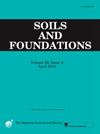实验,建模,和模拟速率依赖的应力应变行为的非束缚的地质材料
IF 3.3
2区 工程技术
Q2 ENGINEERING, GEOLOGICAL
引用次数: 0
摘要
在排水三轴压缩、平面应变压缩、直接剪切和一维压缩(即测径仪测试)下观察到的各种非粘结性岩土材料的粘性特性所引起的速率依赖的应力-应变行为的各种趋势,总结了粘结性岩土材料和其他岩土材料的趋势。结果如下。随着颗粒间接触点的稳定和颗粒抗旋转稳定性的提高,黏性更接近于传统的等压型,即等压型,其应力-应变行为由瞬时不可逆应变速率决定,在恒定应变速率下单调加载(ML)时的强度随着应变速率的增加而增加。在颗粒材料(GMs)中发现了一些非传统(即非等压)类型的性能,它们表现出明显的蠕变、应力松弛和应变速率变化时应力的变化。未结合的差梯度亚角到角GMs表现出所谓的TESRA类型性质(也称为粘性消失类型),其中恒定应变速率下ML期间的应力-应变行为基本上与应变速率无关。未结合的分级差的次圆到圆gm表现出所谓的Positive and Negative (P&;N)型性能,在恒定应变速率下,ML期间的强度随着应变速率的增加而降低。组合类型显示结合了Isotach和TESRA属性类型的中间行为。这些类型的粘性特性通过几个函数和参数进行定量表征,并将其纳入非线性三分量(NTC)模型。NTC模型很好地模拟了所有观察到的速率相关应力-应变行为趋势。本文章由计算机程序翻译,如有差异,请以英文原文为准。
Experiment, modelling, and simulation of rate-dependent stress–strain behaviour of unbound geomaterials
Various trends in rate-dependent stress–strain behaviour caused by the viscous properties of a wide variety of unbound geomaterials that were observed under drained triaxial compression, plane strain compression, direct shear, and one-dimensional compression (i.e., oedometer testing) are summarized referring to those of bound geomaterials and others. The following findings are shown. As the interparticle contact points become more stable and the stability of the particles against rotation increases, the viscous properties become closer to the traditional type, namely, Isotach, whose stress–strain behaviour is determined by the instantaneous irreversible strain rate and whose strength during monotonic loading (ML) at a constant strain rate increases with an increase in the strain rate. A couple of non-traditional (i.e., non-Isotach) types of properties were found with granular materials (GMs) that exhibit noticeable creep deformation, stress relaxation, and changes in stress upon changes in the strain rate. Unbound poorly graded sub-angular to angular GMs exhibit the so-called TESRA type of properties (also called the viscous evanescent type), for which the stress–strain behaviour during ML at a constant strain rate is essentially independent of the strain rate. Unbound poorly graded sub-round to round GMs display the so-called Positive and Negative (P&N) type of properties, for which the strength during ML at a constant strain rate decreases with an increase in the strain rate. The combined type displays intermediate behaviour combining the Isotach and TESRA types of properties. These types of viscous properties are quantitatively characterized by a couple of functions and parameters, and they were incorporated into the non-linear three-component (NTC) model. All the observed trends in rate-dependent stress–strain behaviour are well simulated by the NTC model.
求助全文
通过发布文献求助,成功后即可免费获取论文全文。
去求助
来源期刊

Soils and Foundations
工程技术-地球科学综合
CiteScore
6.40
自引率
8.10%
发文量
99
审稿时长
5 months
期刊介绍:
Soils and Foundations is one of the leading journals in the field of soil mechanics and geotechnical engineering. It is the official journal of the Japanese Geotechnical Society (JGS)., The journal publishes a variety of original research paper, technical reports, technical notes, as well as the state-of-the-art reports upon invitation by the Editor, in the fields of soil and rock mechanics, geotechnical engineering, and environmental geotechnics. Since the publication of Volume 1, No.1 issue in June 1960, Soils and Foundations will celebrate the 60th anniversary in the year of 2020.
Soils and Foundations welcomes theoretical as well as practical work associated with the aforementioned field(s). Case studies that describe the original and interdisciplinary work applicable to geotechnical engineering are particularly encouraged. Discussions to each of the published articles are also welcomed in order to provide an avenue in which opinions of peers may be fed back or exchanged. In providing latest expertise on a specific topic, one issue out of six per year on average was allocated to include selected papers from the International Symposia which were held in Japan as well as overseas.
 求助内容:
求助内容: 应助结果提醒方式:
应助结果提醒方式:


